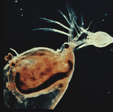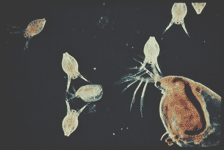Whole Effluent Toxicity Tests (WET)
 Whole effluent toxicity (WET) tests are a critical component of Wisconsin Pollutant Discharge Elimination System (WPDES) permits. The primary goal of WET testing is to ensure that wastewater effluent discharged into Wisconsin surface waters do not negatively impact aquatic ecosystems. The Wisconsin Department of Natural Resources (WDNR) typically incorporates a WET limit into a WPDES permit when wastewater effluent has impacted or has the potential to impact the aquatic environment. By determining the need for a WET limit, the WDNR is able to maintain strict control over wastewater quality. For more information regarding the WDNR’s WET and WPDES regulatory programs, see the WDNR’s website.
Whole effluent toxicity (WET) tests are a critical component of Wisconsin Pollutant Discharge Elimination System (WPDES) permits. The primary goal of WET testing is to ensure that wastewater effluent discharged into Wisconsin surface waters do not negatively impact aquatic ecosystems. The Wisconsin Department of Natural Resources (WDNR) typically incorporates a WET limit into a WPDES permit when wastewater effluent has impacted or has the potential to impact the aquatic environment. By determining the need for a WET limit, the WDNR is able to maintain strict control over wastewater quality. For more information regarding the WDNR’s WET and WPDES regulatory programs, see the WDNR’s website.
What is a WET test?
In whole effluent toxicity (WET) tests, organisms are exposed to various effluent concentrations for a specific time period in order to estimate the effluent’s toxicity. Receiving water (the water which the effluent is discharged into) is used as the dilution water in WET tests in order to simulate what actually happens in the aquatic environment when the effluent is introduced. The most commonly used organisms in WET tests, and the ones required by the WDNR, are the fathead minnow (Pimephales promelas) and an invertebrate (Ceriodaphnia dubia). The WDNR requires two types of WET tests: acute and chronic. The objective of an acute test is to determine the concentration of test material that produces lethality during a short-term exposure (48 or 96 hours). Chronic tests estimate the concentration of effluent that interferes with the growth, development, and reproductive potential of aquatic organisms.
Acute Bioassay
 In Wisconsin, acute tests are conducted with the fathead minnow and Ceriodaphnia dubia and are designed to determine the “end of pipe” conditions (i.e., effects in 100% effluent). Acute tests last 48 to 96 hours. The objective of an acute WET test is to determine the concentration of effluent that causes 50% lethality (LC50) during a short-term exposure under controlled conditions. LC50s are statistical analyses used to estimate the concentration of effluent that causes 50% lethality.
In Wisconsin, acute tests are conducted with the fathead minnow and Ceriodaphnia dubia and are designed to determine the “end of pipe” conditions (i.e., effects in 100% effluent). Acute tests last 48 to 96 hours. The objective of an acute WET test is to determine the concentration of effluent that causes 50% lethality (LC50) during a short-term exposure under controlled conditions. LC50s are statistical analyses used to estimate the concentration of effluent that causes 50% lethality.
Chronic Bioassay
At the WSLH, chronic tests are conducted with the fathead minnow, C. dubia (waterflea) and S. capricornutum (green algae). Chronic tests predict the concentrations that interfere with normal growth, development and reproductive potential of these aquatic organisms. During a chronic test, the organisms are continuously exposed to the test material at various concentrations. Tests last 4-7 days, and responses such as growth, reproduction and survival are measured. Tests are designed to encompass the entire life cycle or most sensitive life stage of the organisms.
 The effects of an effluent in chronic toxicity tests are estimated based on the calculation of the IC25. The IC25 value is a statistical calculation of the effluent concentration which causes a 25% reduction in growth or reproduction of test organisms. The IC25 is then compared to the instream waste concentration (IWC), or the proportion of effluent in the receiving water, to determine if toxicity has occurred at a level of concern. If the IC25 is lower than the IWC, the effluent has the potential to inhibit aquatic organisms in the receiving water.
The effects of an effluent in chronic toxicity tests are estimated based on the calculation of the IC25. The IC25 value is a statistical calculation of the effluent concentration which causes a 25% reduction in growth or reproduction of test organisms. The IC25 is then compared to the instream waste concentration (IWC), or the proportion of effluent in the receiving water, to determine if toxicity has occurred at a level of concern. If the IC25 is lower than the IWC, the effluent has the potential to inhibit aquatic organisms in the receiving water.
Algal Assay
This 48-well microtiter plate assay, developed by the Environmental Toxicology staff, determines the short-term chronic toxicity of effluents to the freshwater alga Selenastrum capricornutum. Chlorophyll content of a sample, indicative of the number of algae present, is measured using a fluorometer, and this data is used to estimate the inhibition concentration (IC50) of the effluent.
Toxicity Reduction Evaluation (TRE) and
Toxicity Identification Evaluation (TIE)
A TRE is a systematic evaluation of the wastewater treatment plant or industrial facility effluent to determine sources of toxicity and ultimately uncover how to control toxicity. TREs may include chemical screening, process reviews, evaluation of treatment plant performance and toxicity identification evaluation (TIE). The objective of a TIE is to characterize and identify the compound(s) causing toxicity. In a TIE, effluent samples are manipulated to remove suspect chemicals and then re-tested to see if toxicity remains. If a specific effluent manipulation removes toxicity, then the researcher has a clue about the source of toxicity.